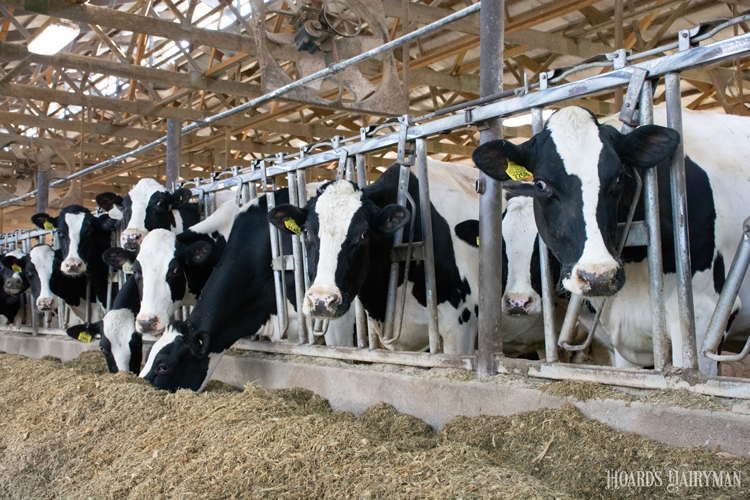
The term neutral detergent fiber (NDF) is familiar to most dairy producers and industry professionals. NDF along with crude protein (CP) are the first two and most important nutritional facts about any feedstuff. I suppose the moisture content would be equally important when dealing with wet forages or by-products. I wonder, though, how many that are familiar with the term NDF know much about what it really is. Furthermore, what is it describing about plant material and the subsequent nutrient supply opportunity in animal diets?
To begin the story, we should go back to Beltsville, Md., in the early 1960s and a researcher named Peter Van Soest. The Beltsville Agricultural Research Center is hallowed grounds for animal science. Set in a beautiful area in Prince George’s County, this expansive 6,000-acre farm is just outside of Washington, D.C. Established in 1910, many of the advancements made in agriculture science since then have been accomplished there.
In addition to the important work completed by Van Soest on better understanding the fiber components of feed, Beltsville had a facility where the early work for the net energy system was completed. Many research facilities could easily measure feed intake along with manure and urine nutrient losses to determine feed digestibility. But it took a more comprehensive measurement ability to also collect gas losses and measure heat increment changes to fully develop the net energy system we still use today. This setup was available in Beltsville.
My personal interaction with the research center was to pull a trailer from Auburn University to Beltsville in the early 1980s to bring back a group of pigs with an unusually long record of breeding information for genetic research. I received a brief tour, but I probably didn’t grasp the significance of the place as an undergraduate student at Auburn. The nutrient system I use every day now some 40 years later was largely developed on that farm, and Van Soest was a key researcher.
Van Soest grew up on a dairy farm in Washington set against the backdrop of the Cascades. After receiving his bachelor’s and master’s degrees at Washington State in the early 1950s, he earned a Ph.D. at the University of Wisconsin with his research project related to low fiber diets in dairy cows. The fiber focus started early for Van Soest! After important years of fiber research for USDA at Beltsville, he joined the faculty at Cornell University, where he continued his research until his retirement. Van Soest passed away in 2021, having just recently published his final paper at age 90. As we daily work to feed cows better, we all owe a lot to Van Soest.
A look at fiber components
So, what does all of this have to do with NDF and my use and interpretation of one of the many forage analysis reports sitting in my inbox this morning? The answer is a lot!
The key nutrient groups in feed and forages nicely add up to 100. These are CP, fat, NDF, starch, sugars, various acids, ash, and finally, soluble fiber. All of this can be derived from almost any forage analysis and is used as the key nutrient loadings for any formulation software. In many models, CP and NDF are the key drivers. For sure, each of these components are further detailed, but these two must be accurate to even get started.
Since the focus for today is NDF, I think it is important for producers to better understand the components of NDF and how it changes with plant maturity and subsequent feed value. In general, NDF starts low and rises with plant maturity. To be specific, NDF is comprised of cellulose, hemicellulose, lignin, and ash. More recently, NDFom (organic matter) has been adopted to remove the ash contribution as it confuses much about the use and interpretation of NDF. The three key items then are cellulose, hemicellulose, and lignin. Without delving deeply into carbohydrate biochemistry, know that hemicellulose can be very highly digestible in the rumen, cellulose is a tougher plant component and has variable digestibility, and lignin is undigestible. In fact, the biggest risk for the potential loss of digestibility of cellulose and hemicellulose is impacted by the growing amount of lignin in a maturing forage. Low lignin is almost always good except for the fact that lignin is literally the rebar of a forage stalk; it’s what keeps the plant upright and more resistant to lodging. Brown midrib (BMR) forages have lower lignin, and this improves fiber digestibility but also elevates the risk of lodging.
In summary, hemicellulose is the most desirable fiber portion included in the NDF fraction. Forages with higher levels of hemicellulose, moderate levels of cellulose, and low lignin will yield the most energy for use by the cow. Adding lab analysis that details the percentage of NDF digested at various time points will best inform the model of how to formulate a ration to match the other feeds in the diet. Don’t forget that it is the synchrony of protein and carbohydrates in the rumen that will harvest the maximum amount of energy from the ration and create the maximum amount of microbial protein. Achieving these two goals will allow the cow to meet its genetic potential and create the greatest profitability for the dairy owner.
More information on Van Soest can be found here and here.








